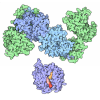[English] 日本語
 Yorodumi
Yorodumi- PDB-3i50: Crystal structure of the West Nile Virus envelope glycoprotein in... -
+ Open data
Open data
- Basic information
Basic information
| Entry | Database: PDB / ID: 3i50 | ||||||
|---|---|---|---|---|---|---|---|
| Title | Crystal structure of the West Nile Virus envelope glycoprotein in complex with the E53 antibody Fab | ||||||
 Components Components |
| ||||||
 Keywords Keywords | VIRAL PROTEIN/IMMUNE SYSTEM / ANTIBODY / FAB / VIRUS / ENVELOPE / IMMUNOGLOBULIN / FUSION LOOP / Disulfide bond / Envelope protein / Membrane / Transmembrane / Virion / VIRAL PROTEIN-IMMUNE SYSTEM complex | ||||||
| Function / homology |  Function and homology information Function and homology informationflavivirin / symbiont-mediated suppression of host JAK-STAT cascade via inhibition of STAT2 activity / symbiont-mediated suppression of host JAK-STAT cascade via inhibition of STAT1 activity / viral capsid / double-stranded RNA binding / nucleoside-triphosphate phosphatase / mRNA (guanine-N7)-methyltransferase / methyltransferase cap1 / methyltransferase cap1 activity / mRNA 5'-cap (guanine-N7-)-methyltransferase activity ...flavivirin / symbiont-mediated suppression of host JAK-STAT cascade via inhibition of STAT2 activity / symbiont-mediated suppression of host JAK-STAT cascade via inhibition of STAT1 activity / viral capsid / double-stranded RNA binding / nucleoside-triphosphate phosphatase / mRNA (guanine-N7)-methyltransferase / methyltransferase cap1 / methyltransferase cap1 activity / mRNA 5'-cap (guanine-N7-)-methyltransferase activity / RNA helicase activity / protein dimerization activity / host cell perinuclear region of cytoplasm / symbiont-mediated suppression of host innate immune response / host cell endoplasmic reticulum membrane / RNA helicase / symbiont-mediated suppression of host type I interferon-mediated signaling pathway / symbiont-mediated activation of host autophagy / RNA-directed RNA polymerase / serine-type endopeptidase activity / viral RNA genome replication / RNA-directed RNA polymerase activity / fusion of virus membrane with host endosome membrane / viral envelope / symbiont entry into host cell / virion attachment to host cell / host cell nucleus / virion membrane / structural molecule activity / ATP hydrolysis activity / proteolysis / extracellular region / ATP binding / metal ion binding / membrane Similarity search - Function | ||||||
| Biological species |  West Nile virus West Nile virus | ||||||
| Method |  X-RAY DIFFRACTION / X-RAY DIFFRACTION /  SYNCHROTRON / SYNCHROTRON /  MOLECULAR REPLACEMENT / Resolution: 3 Å MOLECULAR REPLACEMENT / Resolution: 3 Å | ||||||
 Authors Authors | Nybakken, G.E. / Warren, J.T. / Chen, B.R. / Nelson, C.A. / Fremont, D.H. | ||||||
 Citation Citation |  Journal: EMBO J / Year: 2009 Journal: EMBO J / Year: 2009Title: Structural basis for the preferential recognition of immature flaviviruses by a fusion-loop antibody. Authors: Mickaël V Cherrier / Bärbel Kaufmann / Grant E Nybakken / Shee-Mei Lok / Julia T Warren / Beverly R Chen / Christopher A Nelson / Victor A Kostyuchenko / Heather A Holdaway / Paul R ...Authors: Mickaël V Cherrier / Bärbel Kaufmann / Grant E Nybakken / Shee-Mei Lok / Julia T Warren / Beverly R Chen / Christopher A Nelson / Victor A Kostyuchenko / Heather A Holdaway / Paul R Chipman / Richard J Kuhn / Michael S Diamond / Michael G Rossmann / Daved H Fremont /  Abstract: Flaviviruses are a group of human pathogens causing severe encephalitic or hemorrhagic diseases that include West Nile, dengue and yellow fever viruses. Here, using X-ray crystallography we have ...Flaviviruses are a group of human pathogens causing severe encephalitic or hemorrhagic diseases that include West Nile, dengue and yellow fever viruses. Here, using X-ray crystallography we have defined the structure of the flavivirus cross-reactive antibody E53 that engages the highly conserved fusion loop of the West Nile virus envelope glycoprotein. Using cryo-electron microscopy, we also determined that E53 Fab binds preferentially to spikes in noninfectious, immature flavivirions but is unable to bind significantly to mature virions, consistent with the limited solvent exposure of the epitope. We conclude that the neutralizing impact of E53 and likely similar fusion-loop-specific antibodies depends on its binding to the frequently observed immature component of flavivirus particles. Our results elucidate how fusion-loop antibodies, which comprise a significant fraction of the humoral response against flaviviruses, can function to control infection without appreciably recognizing mature virions. As these highly cross-reactive antibodies are often weakly neutralizing they also may contribute to antibody-dependent enhancement and flavi virus pathogenesis thereby complicating development of safe and effective vaccines. | ||||||
| History |
|
- Structure visualization
Structure visualization
| Structure viewer | Molecule:  Molmil Molmil Jmol/JSmol Jmol/JSmol |
|---|
- Downloads & links
Downloads & links
- Download
Download
| PDBx/mmCIF format |  3i50.cif.gz 3i50.cif.gz | 288.3 KB | Display |  PDBx/mmCIF format PDBx/mmCIF format |
|---|---|---|---|---|
| PDB format |  pdb3i50.ent.gz pdb3i50.ent.gz | 235.9 KB | Display |  PDB format PDB format |
| PDBx/mmJSON format |  3i50.json.gz 3i50.json.gz | Tree view |  PDBx/mmJSON format PDBx/mmJSON format | |
| Others |  Other downloads Other downloads |
-Validation report
| Summary document |  3i50_validation.pdf.gz 3i50_validation.pdf.gz | 447.1 KB | Display |  wwPDB validaton report wwPDB validaton report |
|---|---|---|---|---|
| Full document |  3i50_full_validation.pdf.gz 3i50_full_validation.pdf.gz | 480.8 KB | Display | |
| Data in XML |  3i50_validation.xml.gz 3i50_validation.xml.gz | 29.2 KB | Display | |
| Data in CIF |  3i50_validation.cif.gz 3i50_validation.cif.gz | 38.6 KB | Display | |
| Arichive directory |  https://data.pdbj.org/pub/pdb/validation_reports/i5/3i50 https://data.pdbj.org/pub/pdb/validation_reports/i5/3i50 ftp://data.pdbj.org/pub/pdb/validation_reports/i5/3i50 ftp://data.pdbj.org/pub/pdb/validation_reports/i5/3i50 | HTTPS FTP |
-Related structure data
- Links
Links
- Assembly
Assembly
| Deposited unit | 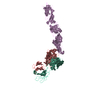
| ||||||||
|---|---|---|---|---|---|---|---|---|---|
| 1 |
| ||||||||
| Unit cell |
|
- Components
Components
| #1: Protein | Mass: 43416.230 Da / Num. of mol.: 1 Source method: isolated from a genetically manipulated source Source: (gene. exp.)  West Nile virus / Strain: NY 1999 / Gene: ENVELOPE / Plasmid: pET21 / Production host: West Nile virus / Strain: NY 1999 / Gene: ENVELOPE / Plasmid: pET21 / Production host:  |
|---|---|
| #2: Antibody | Mass: 22577.018 Da / Num. of mol.: 1 Source method: isolated from a genetically manipulated source Source: (gene. exp.)   |
| #3: Antibody | Mass: 23665.594 Da / Num. of mol.: 1 Source method: isolated from a genetically manipulated source Source: (gene. exp.)   |
| Has protein modification | Y |
-Experimental details
-Experiment
| Experiment | Method:  X-RAY DIFFRACTION / Number of used crystals: 1 X-RAY DIFFRACTION / Number of used crystals: 1 |
|---|
- Sample preparation
Sample preparation
| Crystal | Density Matthews: 2.87 Å3/Da / Density % sol: 57.12 % |
|---|---|
| Crystal grow | Temperature: 293 K / Method: vapor diffusion, hanging drop / pH: 6.5 Details: 30% PEG 300, 0.1 M MES, pH 6.5, VAPOR DIFFUSION, HANGING DROP, temperature 293K |
-Data collection
| Diffraction | Mean temperature: 100 K |
|---|---|
| Diffraction source | Source:  SYNCHROTRON / Site: SYNCHROTRON / Site:  ALS ALS  / Beamline: 4.2.2 / Wavelength: 1.24 Å / Beamline: 4.2.2 / Wavelength: 1.24 Å |
| Detector | Type: NOIR-1 / Detector: CCD / Date: Jun 6, 2006 |
| Radiation | Protocol: SINGLE WAVELENGTH / Monochromatic (M) / Laue (L): M / Scattering type: x-ray |
| Radiation wavelength | Wavelength: 1.24 Å / Relative weight: 1 |
| Reflection | Resolution: 3→50.15 Å / Num. all: 21544 / Num. obs: 21428 / % possible obs: 99.5 % / Redundancy: 4.45 % / Biso Wilson estimate: 110.6 Å2 / Rmerge(I) obs: 0.053 / Net I/σ(I): 12.1 |
| Reflection shell | Resolution: 3→3.11 Å / Redundancy: 4.39 % / Rmerge(I) obs: 0.453 / Mean I/σ(I) obs: 2 / Num. unique all: 2119 / % possible all: 99.8 |
- Processing
Processing
| Software |
| |||||||||||||||||||||||||||||||||||||||||||||||||||||||||||||||||||||||||||||||||||||||||||||||||||||||||||||||||||||||||||||||||||||||||||||||||||||||||||||||||||||||||||||||
|---|---|---|---|---|---|---|---|---|---|---|---|---|---|---|---|---|---|---|---|---|---|---|---|---|---|---|---|---|---|---|---|---|---|---|---|---|---|---|---|---|---|---|---|---|---|---|---|---|---|---|---|---|---|---|---|---|---|---|---|---|---|---|---|---|---|---|---|---|---|---|---|---|---|---|---|---|---|---|---|---|---|---|---|---|---|---|---|---|---|---|---|---|---|---|---|---|---|---|---|---|---|---|---|---|---|---|---|---|---|---|---|---|---|---|---|---|---|---|---|---|---|---|---|---|---|---|---|---|---|---|---|---|---|---|---|---|---|---|---|---|---|---|---|---|---|---|---|---|---|---|---|---|---|---|---|---|---|---|---|---|---|---|---|---|---|---|---|---|---|---|---|---|---|---|---|---|
| Refinement | Method to determine structure:  MOLECULAR REPLACEMENT / Resolution: 3→20 Å / Occupancy max: 1 / Occupancy min: 1 / SU ML: 1.98 / Cross valid method: THROUGHOUT / σ(F): 0 / Stereochemistry target values: ML MOLECULAR REPLACEMENT / Resolution: 3→20 Å / Occupancy max: 1 / Occupancy min: 1 / SU ML: 1.98 / Cross valid method: THROUGHOUT / σ(F): 0 / Stereochemistry target values: ML
| |||||||||||||||||||||||||||||||||||||||||||||||||||||||||||||||||||||||||||||||||||||||||||||||||||||||||||||||||||||||||||||||||||||||||||||||||||||||||||||||||||||||||||||||
| Solvent computation | Shrinkage radii: 0.9 Å / VDW probe radii: 1.11 Å / Solvent model: FLAT BULK SOLVENT MODEL / Bsol: 91.349 Å2 / ksol: 0.307 e/Å3 | |||||||||||||||||||||||||||||||||||||||||||||||||||||||||||||||||||||||||||||||||||||||||||||||||||||||||||||||||||||||||||||||||||||||||||||||||||||||||||||||||||||||||||||||
| Displacement parameters | Biso max: 321.43 Å2 / Biso mean: 146.439 Å2 / Biso min: 42.65 Å2
| |||||||||||||||||||||||||||||||||||||||||||||||||||||||||||||||||||||||||||||||||||||||||||||||||||||||||||||||||||||||||||||||||||||||||||||||||||||||||||||||||||||||||||||||
| Refinement step | Cycle: LAST / Resolution: 3→20 Å
| |||||||||||||||||||||||||||||||||||||||||||||||||||||||||||||||||||||||||||||||||||||||||||||||||||||||||||||||||||||||||||||||||||||||||||||||||||||||||||||||||||||||||||||||
| Refine LS restraints |
| |||||||||||||||||||||||||||||||||||||||||||||||||||||||||||||||||||||||||||||||||||||||||||||||||||||||||||||||||||||||||||||||||||||||||||||||||||||||||||||||||||||||||||||||
| LS refinement shell | Refine-ID: X-RAY DIFFRACTION / Total num. of bins used: 7
| |||||||||||||||||||||||||||||||||||||||||||||||||||||||||||||||||||||||||||||||||||||||||||||||||||||||||||||||||||||||||||||||||||||||||||||||||||||||||||||||||||||||||||||||
| Refinement TLS params. | Method: refined / Refine-ID: X-RAY DIFFRACTION
| |||||||||||||||||||||||||||||||||||||||||||||||||||||||||||||||||||||||||||||||||||||||||||||||||||||||||||||||||||||||||||||||||||||||||||||||||||||||||||||||||||||||||||||||
| Refinement TLS group |
|
 Movie
Movie Controller
Controller









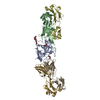

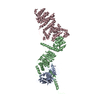
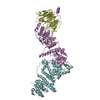

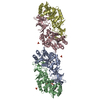
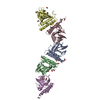
 PDBj
PDBj



